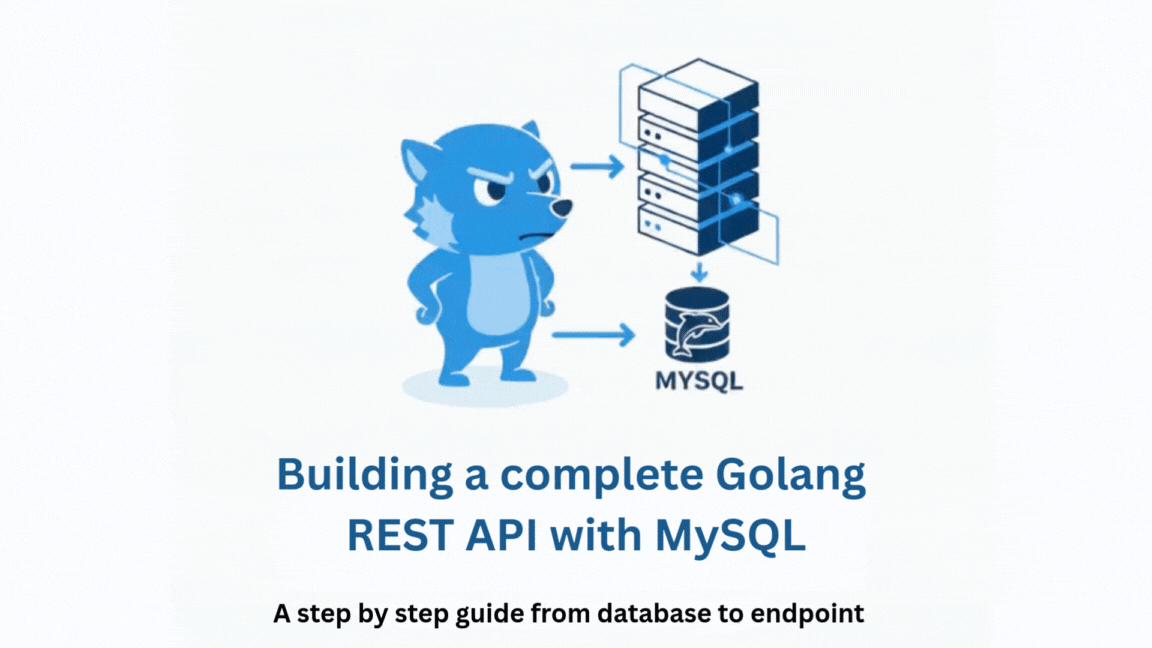Building a Complete Golang REST API with MySQL
Golang (Go) is a fast, statically typed language designed for modern backend development. In this tutorial, we’ll create a complete REST API in Go with MySQL integration and demonstrate unit testing to ensure our API works correctly. By the end, you’ll have a full CRUD API ready to extend for real-world applications.
Why Build a REST API in Go?
Go is ideal for backend APIs because:
- Performance: Compiled language with low latency.
- Concurrency: Handles multiple requests efficiently with goroutines.
- Simplicity: Minimal boilerplate, clear syntax.
- Scalability: Perfect for microservices and cloud-native apps.
Adding MySQL integration and unit tests ensures your API is reliable and production-ready.
Project Overview
We’ll build a User API with the following features:
- CRUD operations: Create, Read, Update, Delete users
- MySQL database integration
- JSON API responses
- Unit tests using Go’s
testingpackage
Project Structure:
golang-mysql-api/
│
├── main.go
├── go.mod
├── db/
│ └── db.go
├── models/
│ └── user.go
├── handlers/
│ └── user_handler.go
└── tests/
└── user_test.go
Step 1: Initialize Go Module
go mod init golang-mysql-api
go get -u github.com/go-sql-driver/mysql
go get -u github.com/gorilla/mux
This sets up your project and installs the necessary dependencies for MySQL and HTTP routing.
Step 2: Connect to MySQL (db/db.go)
package db
import (
"database/sql"
"fmt"
"log"
_ "github.com/go-sql-driver/mysql"
)
var DB *sql.DB
func Connect() {
var err error
dsn := "root:password@tcp(127.0.0.1:3306)/golang_api"
DB, err = sql.Open("mysql", dsn)
if err != nil {
log.Fatal("Database connection failed: ", err)
}
err = DB.Ping()
if err != nil {
log.Fatal("Database ping failed: ", err)
}
fmt.Println("Database connected successfully")
}
This file handles connecting to your MySQL database. Make sure to update the dsn with your credentials.
Step 3: Define the User Model (models/user.go)
package models
type User struct {
ID int `json:"id"`
Name string `json:"name"`
Email string `json:"email"`
}
We define a simple User struct to represent our database table.
Step 4: Create API Handlers (handlers/user_handler.go)
package handlers
import (
"encoding/json"
"net/http"
"strconv"
"github.com/gorilla/mux"
"golang-mysql-api/db"
"golang-mysql-api/models"
)
func GetUsers(w http.ResponseWriter, r *http.Request) {
rows, err := db.DB.Query("SELECT id, name, email FROM users")
if err != nil {
http.Error(w, err.Error(), http.StatusInternalServerError)
return
}
defer rows.Close()
users := []models.User{}
for rows.Next() {
var user models.User
rows.Scan(&user.ID, &user.Name, &user.Email)
users = append(users, user)
}
json.NewEncoder(w).Encode(users)
}
func GetUser(w http.ResponseWriter, r *http.Request) {
params := mux.Vars(r)
id, _ := strconv.Atoi(params["id"])
var user models.User
err := db.DB.QueryRow("SELECT id, name, email FROM users WHERE id=?", id).Scan(&user.ID, &user.Name, &user.Email)
if err != nil {
http.Error(w, "User not found", http.StatusNotFound)
return
}
json.NewEncoder(w).Encode(user)
}
func CreateUser(w http.ResponseWriter, r *http.Request) {
var user models.User
json.NewDecoder(r.Body).Decode(&user)
res, err := db.DB.Exec("INSERT INTO users(name, email) VALUES(?, ?)", user.Name, user.Email)
if err != nil {
http.Error(w, err.Error(), http.StatusInternalServerError)
return
}
id, _ := res.LastInsertId()
user.ID = int(id)
json.NewEncoder(w).Encode(user)
}
func UpdateUser(w http.ResponseWriter, r *http.Request) {
params := mux.Vars(r)
id, _ := strconv.Atoi(params["id"])
var user models.User
json.NewDecoder(r.Body).Decode(&user)
_, err := db.DB.Exec("UPDATE users SET name=?, email=? WHERE id=?", user.Name, user.Email, id)
if err != nil {
http.Error(w, err.Error(), http.StatusInternalServerError)
return
}
user.ID = id
json.NewEncoder(w).Encode(user)
}
func DeleteUser(w http.ResponseWriter, r *http.Request) {
params := mux.Vars(r)
id, _ := strconv.Atoi(params["id"])
_, err := db.DB.Exec("DELETE FROM users WHERE id=?", id)
if err != nil {
http.Error(w, err.Error(), http.StatusInternalServerError)
return
}
w.WriteHeader(http.StatusNoContent)
}
Step 5: Main File (main.go)
package main
import (
"fmt"
"log"
"net/http"
"github.com/gorilla/mux"
"golang-mysql-api/db"
"golang-mysql-api/handlers"
)
func main() {
db.Connect()
router := mux.NewRouter()
router.HandleFunc("/users", handlers.GetUsers).Methods("GET")
router.HandleFunc("/users/{id}", handlers.GetUser).Methods("GET")
router.HandleFunc("/users", handlers.CreateUser).Methods("POST")
router.HandleFunc("/users/{id}", handlers.UpdateUser).Methods("PUT")
router.HandleFunc("/users/{id}", handlers.DeleteUser).Methods("DELETE")
fmt.Println("Server running on port 8080")
log.Fatal(http.ListenAndServe(":8080", router))
}
Step 6: MySQL Setup
CREATE DATABASE golang_api;
USE golang_api;
CREATE TABLE users (
id INT AUTO_INCREMENT PRIMARY KEY,
name VARCHAR(100),
email VARCHAR(100)
);
Step 7: Writing Unit Tests (tests/user_test.go)
package tests
import (
"bytes"
"encoding/json"
"net/http"
"net/http/httptest"
"testing"
"github.com/gorilla/mux"
"golang-mysql-api/handlers"
)
func TestCreateUser(t *testing.T) {
user := map[string]string{"name": "Alice", "email": "alice@example.com"}
body, _ := json.Marshal(user)
req, _ := http.NewRequest("POST", "/users", bytes.NewBuffer(body))
rr := httptest.NewRecorder()
handler := http.HandlerFunc(handlers.CreateUser)
handler.ServeHTTP(rr, req)
if status := rr.Code; status != http.StatusOK {
t.Errorf("Expected status 200, got %v", status)
}
}
func TestGetUsers(t *testing.T) {
req, _ := http.NewRequest("GET", "/users", nil)
rr := httptest.NewRecorder()
handler := http.HandlerFunc(handlers.GetUsers)
handler.ServeHTTP(rr, req)
if status := rr.Code; status != http.StatusOK {
t.Errorf("Expected status 200, got %v", status)
}
}
func TestGetUserNotFound(t *testing.T) {
req, _ := http.NewRequest("GET", "/users/9999", nil)
rr := httptest.NewRecorder()
router := mux.NewRouter()
router.HandleFunc("/users/{id}", handlers.GetUser)
router.ServeHTTP(rr, req)
if status := rr.Code; status != http.StatusNotFound {
t.Errorf("Expected status 404, got %v", status)
}
}
Tips
- Always use Go modules (
go mod) for dependency management. - Use
httptestto simulate requests for unit testing APIs. - Validate user input in production to prevent SQL injection.
- Use environment variables for DB credentials instead of hardcoding.




